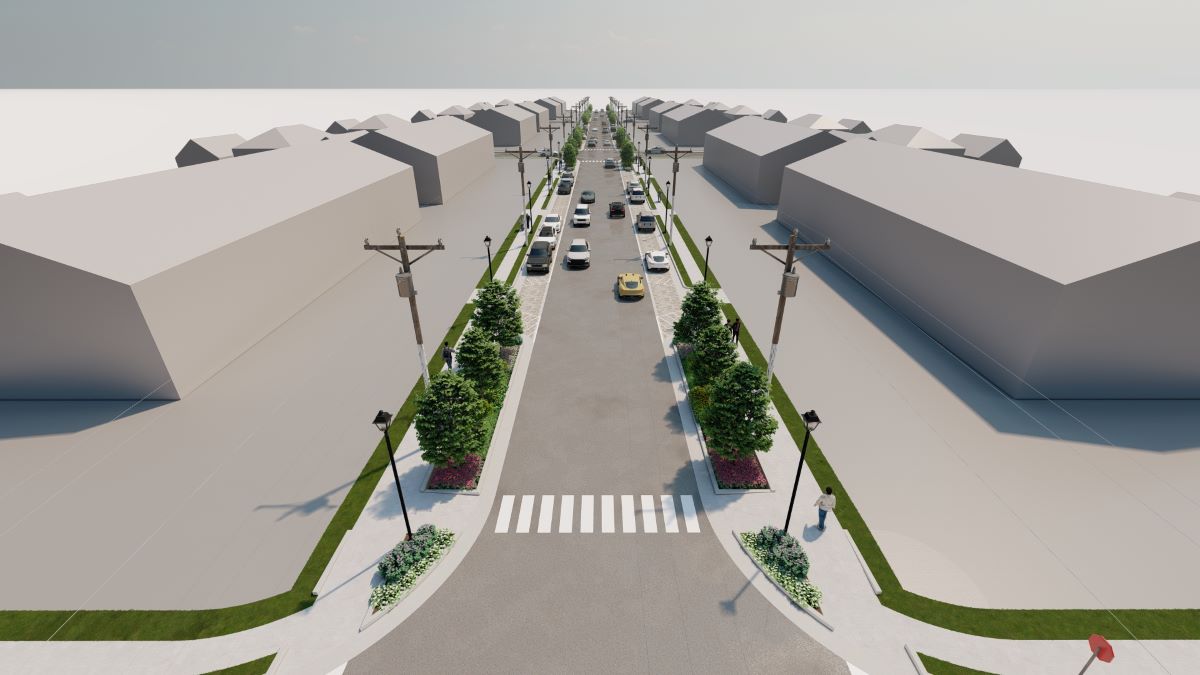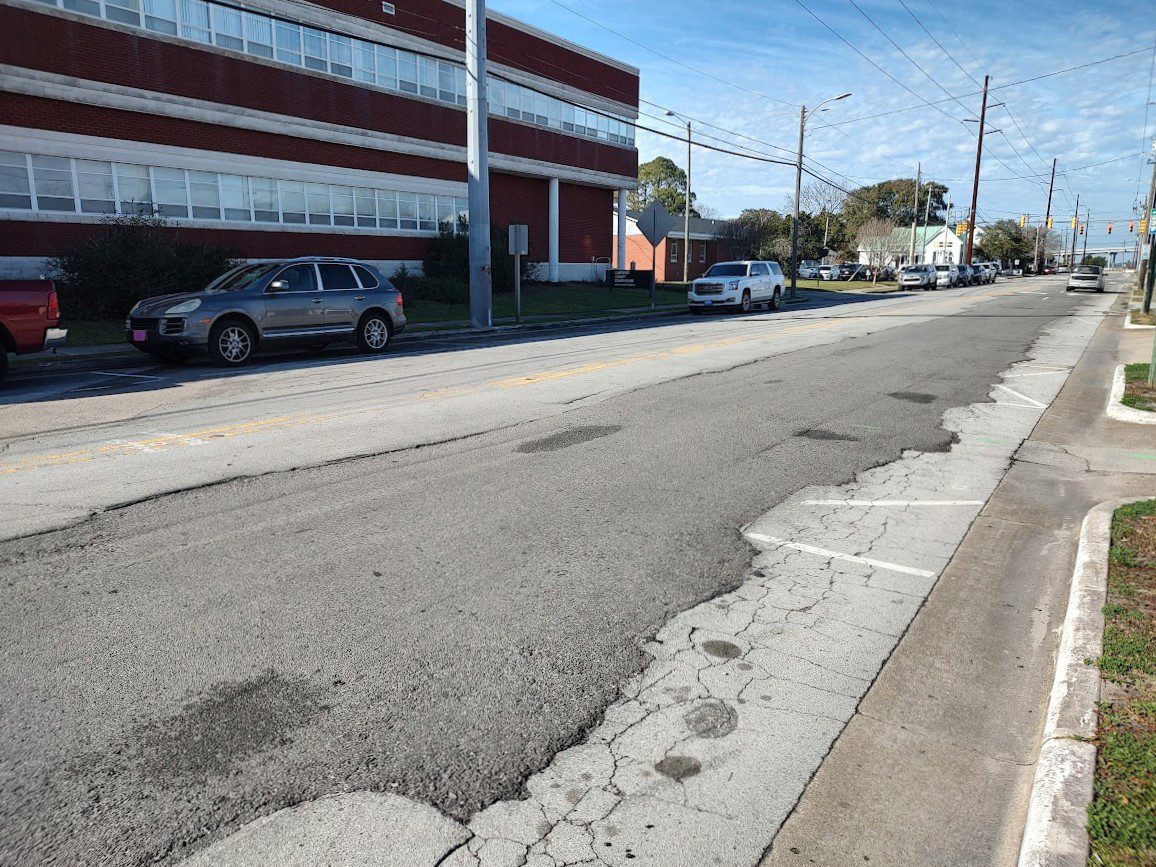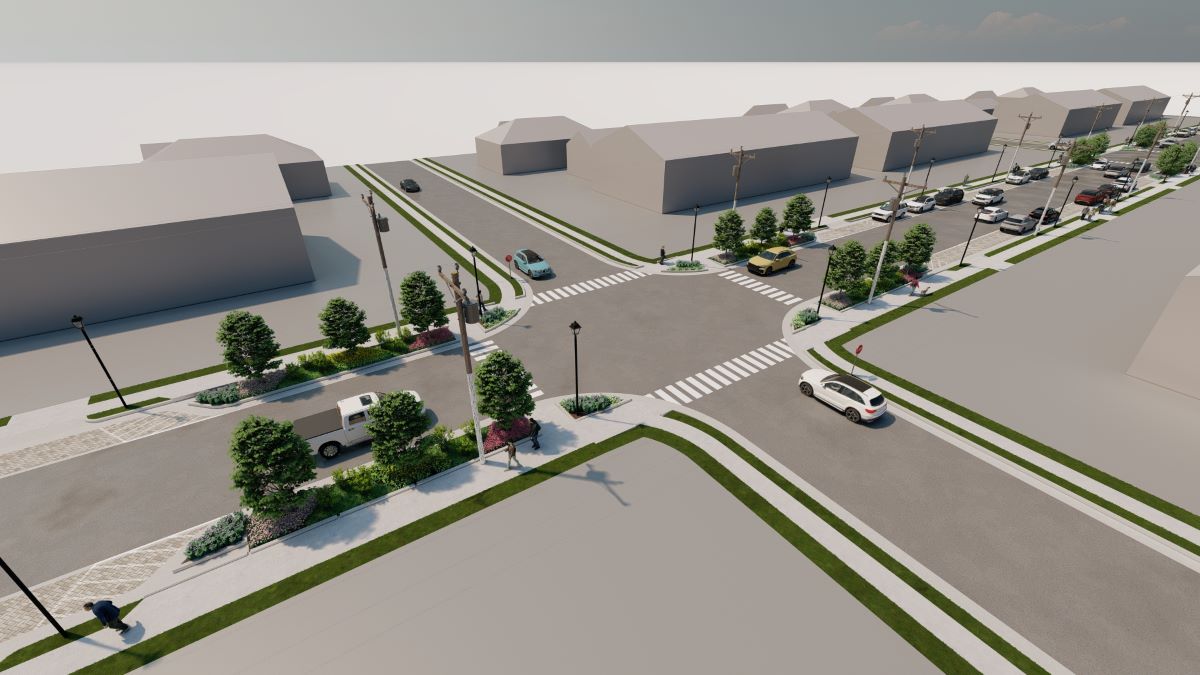
BEAUFORT — Now that Cedar Street no longer serves as the main road through town, as it had been for decades before a U.S. 70 realignment project around town was completed in 2019, work can begin on the bumps, cracks, holes and the resulting complaints from motorists.
Two projects aimed at mitigating stormwater runoff along Cedar Street are to take place this year, with one that began Monday, before the North Carolina Department of Transportation, which maintains the road, resurfaces it, officials said. The projects feature pervious pavement and bioretention. These are nature-based stormwater strategies designed to maintain or mimic a site’s natural hydrology with capacity to collect, soak in and filter stormwater runoff.
Supporter Spotlight
Beaufort was selected in late 2022 for a $195,500 grant through the Water Resources Development Grant program for the Cedar Street pervious parking project. The project is expected to cost around $391,000. The North Carolina Coastal Federation, which advocates for water quality improvements and publishes Coastal Review, has pledged $75,000 and the town is responsible for $120,500.
This plan is to install 16,600 square feet of pervious pavement in the parking lanes of Cedar Street between Orange and Marsh streets, about five blocks. The pervious pavement, which allows water to seep through rather than puddle on the surface, is anticipated to capture 6.4 acres of stormwater runoff from adjacent properties and streets. This should reduce the amount of polluted water making it the impaired Town Creek watershed, according to the town.
“Your ongoing efforts to improve the condition of water resources in your jurisdiction are to be commended,” said Division of Water Resources Director Richard Rogers Jr. in a Nov. 2, 2022, letter to town staff and officials.

Town officials announced Friday that NCDOT was planning to begin work Monday, Jan. 9, to remove existing curb, asphalt and sidewalk at several intersections along Cedar Street starting at the intersection of Cedar and Orange streets working toward the intersection of Cedar and Marsh streets.
The NCDOT project for Cedar Street is to build 14 bioswales at the corners of four street intersections with the underdrains connected to the stormwater main that was replaced early last year.
Supporter Spotlight
Bioswales, in this case, are vegetated low-lying areas or troughs, like a rain garden, where a gutter or storm drain would usually be installed. The pervious pavement will be installed between these bioswales.
Town perspective
Beaufort Town Engineer Greg Meshaw explained that with the U.S. 70 bypass and the fixed-span Gallants Channel bridge that opened in 2018 and replaced the half-century-old, two-lane drawbridge connecting Beaufort and Radio Island, Cedar Street was no longer the major thoroughfare and longstanding water infrastructure problems below the street – the reason for the years of bumpy pavement — could be addressed.
“Accordingly, NCDOT desires to turn the street over to the Town. Before doing so, the Department will renew the street pavement,” Meshaw said in the email response to Coastal Review. “Given this plan, the Town completed a project to replace and rehabilitate the water and sewer mains beneath the street. NCDOT also replaced the existing stormwater line beneath the street, which was found to be failing at several locations.”
He added that NCDOT plans to begin its Cedar Street paving project in June.
“The project to essentially reconstruct Cedar Street presented the perfect opportunity for inclusion of a project to construct pervious pavement,” Meshaw said.

Because the parking lanes are to be constructed with pervious pavement between the bioswales, the pavement should help reduce the runoff and increase the efficiency of bioswales at filtering pollutants, particularly during smaller storm events.
“The two projects are viewed as a step toward the Town’s goal of watershed restoration,” he said in the email.
The town’s watershed restoration plan approved by the state in 2017 points to stormwater runoff as the primary pollutant source for Town Creek.
“The town is grateful to NCDOT for allowing the pervious pavement project to be incorporated into the overall work given that the street is still under their jurisdiction,” he added.
NCDOT’s use of nature-based strategies
Ryan M. Mullins, retrofits program manager for the highway stormwater program in the NCDOT Hydraulics Unit, told Coastal Review that the Cedar Street project presented a unique opportunity to take advantage of the road no longer being a part of the U.S. 70 route corridor because of the bypass. NCDOT plans to turn Cedar Street over to Beaufort for future maintenance.
“The NCDOT Hydraulics Unit was able to work with the Town of Beaufort and local NCDOT forces to explore adding stormwater practices, which previously did not exist, as part of this opportunity. This stormwater project allows NCDOT to contribute toward beautification and revitalization of Cedar Street, while also providing stormwater treatment of roadway runoff that eventually drains to Town Creek,” he said.
Construction on the bioretention bump-outs, or bioswales, is slated to begin this month and is anticipated to wrap up by the spring in order to avoid the tourist season, Mullins added.

NCDOT decided to use nature-based strategies rather than conventional repaving because the agency “strives to identify context-sensitive solutions for its transportation infrastructure,” he explained. “Given the historic nature of Beaufort and the natural beauty of the area, we felt it was important to incorporate nature-based stormwater solutions to compliment the character of the community.”
Cedar Street does present challenges for incorporating stormwater best management practices, or BMPs, which include controlling flooding, reducing erosion and improving water quality.
For example, the road is in an urban setting with numerous homes and businesses on both sides. There is limited NCDOT right-of-way, and thus no areas for more traditional stormwater BMPs, and numerous overhead utilities and underground utilities to contend with, as well, Mullins said.
“Traditional stormwater practices are not always appropriate or feasible, especially in the urban setting. By making use of more nature-based strategies and practices that work well in the urban environment, we are able to incorporate stormwater treatment into the urban setting, providing the benefits to the local community through the aesthetics and stormwater treatment that these types of practices bring,” he said.
As part of NCDOT’s statewide National Pollutant Discharge Elimination System stormwater permit programs, the agency is charged with protecting water quality and reducing pollutant loading, Mullins added.
“One of the ways we do this is through our Stormwater Retrofit Program, where we locate, design and construct stormwater controls to mitigate and treat stormwater runoff before it enters the states waterways,” he said. “I believe that this project will set an example of what we can accomplish with strong local partnerships to incorporate stormwater practices within a slow speed local road environment, that not only treat stormwater runoff, but also enhance the aesthetics of these areas.”
The Coastal Federation’s role
Bree Charron, coastal engineer with the Coastal Federation, said the project came about as “a classic case of having the right people in the room at the right time.”
During one of the town’s stormwater committee meetings five or six years ago, the Coastal Federation coordinated with the NCDOT Hydraulics Unit retrofit staff on a presentation, and updating Cedar Street came up.

“It appeared to be the perfect opportunity for a retrofit project since they would be doing a lot of road work before handing the street over to the town. So, the NCDOT retrofit team worked to plan and design the bioswale bump-outs,” Charron said.
Last year, NCDOT switched engineering firms for this project to Raleigh-based McAdams Co. The engineers pitched the idea of pervious pavement in the parking areas between the bioswales.
Charron said Meshaw, the town engineer, asked for her help to find additional funding to make sure the project happened.
“The North Carolina Water Resources Development Grant seemed like the perfect fit, so we went for it. The federation is contributing $75,000 from our state appropriation to restore water quality in the Newport River to aid the town’s match. This was an unexpected expenditure for the town, but the timing and overall benefits of the project led them to commit the other portion of the match,” she said.
The Newport River in Carteret County runs 12 miles southeast through the town of Newport flowing ultimately into Bogue Sound between Morehead City and Beaufort, according to the Coastal Federation.
The nonprofit committed the $75,000 because “we have been involved in making this Cedar Street project happen since the very beginning and wanted to see it reach its full potential,” Charron explained. “It just happened to line up perfectly with our funding to implement water quality projects in the Newport River watershed.”
She added that the organization is currently working with stakeholders from Beaufort, Morehead City, Newport and Carteret County to develop a Newport River Estuary Restoration Plan.
“Cedar Street is one of the main sources of direct discharge of stormwater into Town Creek and then the river. This project will reduce the volume of stormwater reaching the creek and help filter out pollutants,” she said.
This is one of several water quality projects in which the Coastal Federation has partnered with Beaufort.
“We helped them develop a watershed restoration plan back in 2017 and have been working to install projects that meet the goals of that plan since then,” she said.
“Other installed projects include the pervious parking on Orange Street, the Topsail Park rain gardens, and the retrofit of the Wildlife Resources Commission boat ramp on Lennoxville to name a few. This project adds to Beaufort’s growing list of stormwater retrofits and implementation projects that show their dedication to clean water quality in their receiving waters.”
Coastal Federation Deputy Director Lauren Kolodij told Coastal Review that moving away from conventional repaving, which is standard practice, to using nature-based strategies like permeable paving and infiltration was an idea that she presented to NCDOT, and officials there were receptive.
“We are trying to get local governments, DOT and everyone to look at opportunities to not just approach capital improvement projects the same old way — pull up pavement, fix problem and then repave — but instead look for opportunities to make a project better and more effective at reducing stormwater with nature-based strategies identified in the nature-based strategies action plan we developed in 2021,” Kolodij said.







